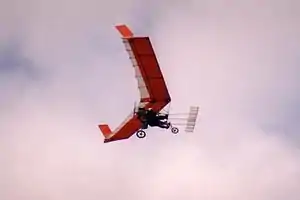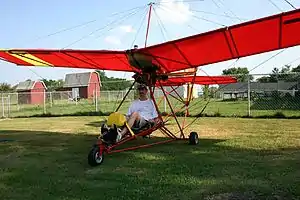Ultralight aircraft (United States)
Ultralight aircraft in the United States are much smaller and lighter than ultralight aircraft as defined by all other countries.

In the United States, ultralights are described as "ultralight vehicles" and not as aircraft. They are not required to be registered, nor is the pilot required to have a pilot's certificate.[1][2]
United States definition of "ultralight"
Regulation of ultralight aircraft in the United States is covered by the Code of Federal Regulations, Title 14 (Federal Aviation Regulations), Part 103, or 14 CFR Part 103, which defines an "ultralight" as a vehicle that:
- has only one seat[1][2]
- Is used only for recreational or sport flying[1][2]
- Does not have a U.S. or foreign airworthiness certificate[1]
- If unpowered, weighs less than 155 pounds[1]
- If powered:
- Weighs less than 254 pounds (115 kg) empty weight, excluding floats and safety devices[1]
- Has a maximum fuel capacity of 5 U.S. gallons (19 L)[2]
- Has a top speed of 55 knots (102 km/h; 63 mph) calibrated airspeed at full power in level flight[1]
- Has a power-off stall speed which does not exceed 24 knots (45 km/h; 28 mph) calibrated airspeed or less[1]
Certification
- Ultralight vehicles and their component parts and equipment are not required to meet the airworthiness certification standards specified for aircraft or to have certificates of airworthiness.[1]
- Operators of ultralight vehicles are not required to meet any aeronautical knowledge, age, or experience requirements or to have airman or medical certificates.[1]
- Ultralight vehicles are not required to be registered or to have registration markings.[1]
Operations
- Ultralight vehicle cannot be flown except between the hours of sunrise and sunset.[1]
- Ultralight vehicles may be operated during the twilight periods 30 minutes before official sunrise and 30 minutes after official sunset or, in Alaska, during the period of civil twilight as defined in the Air Almanac, if:
- The vehicle has an operating anti-collision light visible for at least 3 statute miles[1]
- Flight can only take place in uncontrolled airspace[1]
Ultralight vehicles cannot be flown over any congested area of a city, town, or settlement, or over any open air assembly of persons.[1]
Weight allowances can be made for amphibious landing gear, and ballistic parachute systems.[1]
In the United States, while no certification or training is required by law for ultralights, training is strongly advised.[2]
See also
References
- Federal Aviation Administration (January 2007). "Title 14: Aeronautics and Space, Part 103 - Ultralight Vehicles". Retrieved 2017-10-25.
- United States Ultralight Association (2009). "Frequently asked Questions". Retrieved 2009-08-16.

